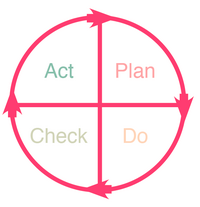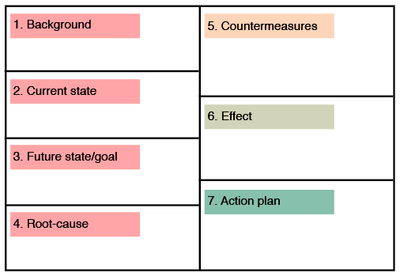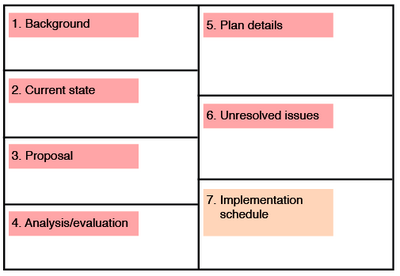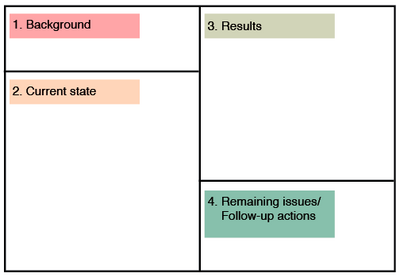The A3 report
| Line 6: | Line 6: | ||
| − | [[File:PDCA3.png|200px|thumb|right|Figure 1: The PDCA cycle]] The name of the "A3 report" refers to the standard size A3-paper on which it fits. The idea behind the tool was developed by Toyota and was used from the 1960’s. It became a part of the Toyota Production System as a standard for problem solving, proposals, plans and status reviews. The A3 report is evolved around a Plan-Do-Check-Act (PDCA) cycle developed by Walter Shewhart. The PDCA system is a way of continuously improving and managing an organization in a systematic way. The A3 documents the findings from the PDCA cycle but is very flexible to the problem for which it is used to analyze. | + | [[File:PDCA3.png|200px|thumb|right|Figure 1: The PDCA cycle]] The name of the "A3 report" refers to the standard size A3-paper on which it fits. The idea behind the tool was developed by Toyota and was used from the 1960’s. It became a part of the Toyota Production System as a standard for problem solving, proposals, plans and status reviews. The A3 report is evolved around a Plan-Do-Check-Act (PDCA) cycle developed by Walter Shewhart. The PDCA system is a way of continuously improving and managing an organization in a systematic way. The A3 documents the findings from the PDCA cycle but is very flexible to the problem for which it is used to analyze.<ref name=''(Schwagerman, 2013)''> ''Schwagerman III, W. C., & Ulmer, J. M. (2013). The A3 Lean Management and Leadership Thought Process. Journal of Technology, Management & Applied Engineering, 29(4).'' </ref>The A3 describes in principal the chronologically story of the PDCA in one or more A3’s by step wise going through the different stages of the PDCA. For this reason the A3 report has been referred to as “Standardised storytelling”. Even though the tool origins and is widely used in manufacturing, it has been applied successfully in a range of industries such as healthcare, for educational purposes as well as aircraft maintenance. construction. |
| Line 220: | Line 220: | ||
[[File:Overview.png|600px|thumb|left|Figure 2: Comparison of the classic A3 report contents]] | [[File:Overview.png|600px|thumb|left|Figure 2: Comparison of the classic A3 report contents]] | ||
| + | |||
| + | |||
| + | |||
| + | |||
| + | Ashrafi, Maryam, Hamid Davoudpour, and Mohammad Abbassi. "Developing A Decision Support System For R&D Project Portfolio Selection With Interdependencies." AIP Conference Proceedings 1499.1 (2012): 370-378. Academic Search Premier. | ||
| + | |||
| + | |||
| + | To create a reference link in the text like this [1], write <ref name=''name''> ''link/title'' </ref> | ||
| + | Refer to the same reference again by writing: <ref name=''Name'' /> | ||
| + | Create a reference list like this one, by writing <references /> | ||
Revision as of 22:16, 23 November 2014
Contents |
Abstract
The A3 report is a widely used LEAN-tool which derives from Toyota's production system. It is used in various industries and has a range of different applications. Most commonly the A3 report is used as a tool for problem-solving, communication, knowledge-sharing etc. in organisations. This article will describe the origin of the A3 report and the different types of A3 reports. An overview of the different elements in the A3 reports in combination with a stepwise description of the use is provided. Furthermore it will be described how to choose and customize one or more A3 reports for portfolio management as well as implementation advice.
Introduction
The name of the "A3 report" refers to the standard size A3-paper on which it fits. The idea behind the tool was developed by Toyota and was used from the 1960’s. It became a part of the Toyota Production System as a standard for problem solving, proposals, plans and status reviews. The A3 report is evolved around a Plan-Do-Check-Act (PDCA) cycle developed by Walter Shewhart. The PDCA system is a way of continuously improving and managing an organization in a systematic way. The A3 documents the findings from the PDCA cycle but is very flexible to the problem for which it is used to analyze.[1]The A3 describes in principal the chronologically story of the PDCA in one or more A3’s by step wise going through the different stages of the PDCA. For this reason the A3 report has been referred to as “Standardised storytelling”. Even though the tool origins and is widely used in manufacturing, it has been applied successfully in a range of industries such as healthcare, for educational purposes as well as aircraft maintenance. construction.
A3 report applications
Today the A3 report is a common LEAN tool used as a part of LEAN management. The A3 report has developed into several variations as specific tools for problem solving, innovating, planning as well as a general thinking within all levels of an organization. This has lead to the A3 report not only being a problem-solving tool but a tool that facilitates the A3-thinking in different ways. Common for the different types of A3 reports is that they follow the PDCA cycle. This section provides and overview of the different types of A3’s as well as their content.
The problem-solving A3 report
This A3 report is the most common type of A3 report.
Description of steps The problem-solving A3 report consists overall of the elements covering each of the phases in the PDCA cycle.
Plan
A description of the problem, background and context that provides an understanding of the root causes of the problem . This phase usually takes up the left half of the A3 report.
1. Background
This section describes the extend and importance of the problem.
2. Current state
This section describes the current situation within the company in relation to the problem. It is recommended to use a high level of facts and figures in a simple way which is easily read and understand.
3. Future state/goal
The goals for the future state is described in this section.
4. Root-cause analysis
The root-cause of the problem describes what needs to be solved in order to achieve the goal. There are several ways to analyse the root cause:
- The Toyota way: asking why five times or until the root-cause is found
- The Ishikawa “fishbone diagram”
- The reality tree
Do
5. Countermeasures
In this section different countermeasures for hypotheses are described and tested by changing and adjusting different parameters. Testing and exploration of the many different countermeasures creates a more thought through basis for choosing the best solution. The countermeasures should solve the gap between current state and the desired future state.
Check
6. Effect
Studies the effect of the “Do” phase. It discusses the success and failure of the implemented countermeasures. The “Check” section of the A3-report is in some templates integrated in the “Do” section and in other templates it is a separate section.
Act
7. Action plan
In this phase an action plan is created to solve the long-term problem. It is analysed if standardization should be implemented based on a positive outcome from the countermeasures. The action plan can be made in different ways e.g. as a list of actions or an actual project plan with timelines . If the countermeasures were not beneficial the PDCA cycle can be repeated as an iterative process.
The proposal A3 report
This type of A3-report has the purpose of creating a proposal to the organization. This means that it isn’t necessarily a problem that the A3 owner wants to address but it might be an opportunity. Furthermore the emphasis of this type of A3 is placed on the planning-phase.
Plan
1. Background
This section describes the extent and importance of the problem or opportunity.
2. Current state
This section describes the current situation within the company in relation to the problem or opportunity. It is recommended to use a high level of facts and figures in a simple way which is easily read and understand.
3. Analysis/evaluation of alternatives
This section is highly dependent on the type of proposal and if it’s a problem or an opportunity. If the A3 report describes a proposal of a future state this step might be irrelevant.
4. Proposal
This section should describe the a concise proposal statement and an analysis of what is achieved including savings in terms of cost and time.
5. Plan details
The details of the implementation are described in this section. This can include a list of actions in order to achieve the proposal.
6. Unresolved issues (optional)
This section functions as a “parking lot” for issues that should be addressed in relation to the proposal but for various reasons are out of scope of the project.
Do, check, act
7. Implementation schedule
Similar to the problem-solving A3 the proposal A3 contains a detailed timeline describing execution.
The status A3 report
This type of A3 report reviews the project and can be used at various points in time during a project as well as provide an end status .
Plan
1. Background
This section describes the extent and importance of the problem or opportunity. For the status A3 this section has a high dependency on who the receiver of the review is and the knowledge of this person.
Do
2. Current state
The current state describes the new state after actions have been taken or a summary of the changes. The current state could be described by using a Gantt Chart.
Check
3. Results
This section describes the obtained results from the actions taken at the point in time. Often this section related to metrics such as quality, cost and time.
Act
4. Remaining issues/follow-up actions
Describes the steps necessary to accomplish the goal of the project.
Overview and discussion
The following figure presents the content of each of the three standard A3 report templates described above. The colorcodes describe which of the phases in the PDCA cycle the content belongs to.
Ashrafi, Maryam, Hamid Davoudpour, and Mohammad Abbassi. "Developing A Decision Support System For R&D Project Portfolio Selection With Interdependencies." AIP Conference Proceedings 1499.1 (2012): 370-378. Academic Search Premier.
To create a reference link in the text like this [1], write [2]
Refer to the same reference again by writing: Cite error: Invalid <ref> tag;
refs with no content must have a name




